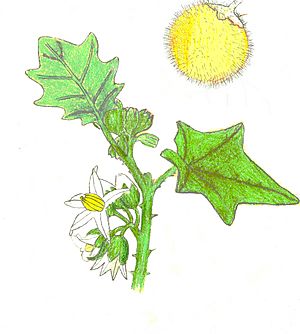Solanum lasiocarpum facts for kids
Quick facts for kids Solanum lasiocarpum |
|
|---|---|
 |
|
| A drawling of Solanum lasiocarpum. | |
| Scientific classification | |
| Genus: |
Solanum
|
| Species: |
lasiocarpum
|
| Synonyms | |
|
|
Solanum lasiocarpum is a plant with edible fruit. It is also known by other names like Indian nightshade or hairy-fruited eggplant. Sometimes, it is called Solanum ferox, which is another scientific name for the same plant. This plant has white flowers and its fruits are a light yellow color.
Contents
About the Indian Nightshade
The Indian nightshade is a fascinating plant. Its fruits are not only tasty but also have a light green color inside, similar to another plant called Solanum quitoense.
Where Does It Grow?
You can find Solanum lasiocarpum growing wild in many parts of Asia. This includes places like the Andaman Islands, Sri Lanka, and areas in Indochina. It also grows in southern China, Taiwan, and across much of Malesia and Papuasia. You can even find it in Queensland, Australia.
In other countries, people mostly grow this plant on farms or in gardens. When grown by people, the plants are called "domesticated."
Wild vs. Domesticated Plants
There's a cool difference between wild and domesticated Indian nightshade plants.
- Wild plants often have prickly skin on their fruits.
- Domesticated plants are grown to be easier to eat. Their fruits are usually larger and do not have the prickly skin. This makes them much nicer for people to use!
What Is It Used For?
People use the Indian nightshade in many ways, especially in tropical parts of Asia.
- Food: The fruit is used to add flavor to food. In India, people use it to make a sour relish for curries. In Thailand, it's an important ingredient in a special sauce called nam prek.
- Traditional Medicine: Sometimes, the fruit is used in traditional folk medicine to help sick people.
Plant Family Connections
Scientists are very interested in Solanum lasiocarpum because it looks a lot like some plants from South America. These include the cocona (S. sessiliflorum), the naranjilla (S. quitoense), and the pseudolulo (S. pseudolulo).
These four plants are closely related. If you grow them together outside their natural homes, they can easily mix their genes. This process is called "hybridizing." When they hybridize, they create new plants that cannot have babies of their own. This might sound strange, but it's important for scientists. It could help make these plants more useful for farming and food production around the world.

